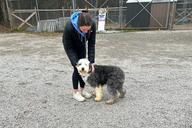You have /5 articles left.
Sign up for a free account or log in.
James Heaps was a fixture at the University of California, Los Angeles. The physician worked in the student health center part-time for nearly 30 years. Later, he would move to UCLA’s medical center, UCLA Health.
But last year, officials fired Heaps after he was accused of sexual abuse. And Monday, Heaps was charged with sexual battery in connection with two patients (not students) he treated at UCLA Health.
The allegations were shocking enough -- a trusted, longtime doctor purportedly exploiting vulnerable patients. But they were compounded because of the myriad incidents in academe involving physicians and alleged sexual assault, including UCLA’s neighbor, the University of Southern California.
There, a campus gynecologist allegedly sexually assaulted young women for decades without being noticed. University officials who were warned of George Tyndall’s actions did not fire him, despite an investigation revealing he had likely preyed on students and had signs of “psychopathy.” Instead, the university arranged a deal to pay him off and allowed him to step down. The fallout from Tyndall resulted in the ouster of USC's president, among other top administrators, and a $215 million settlement stemming from lawsuits against the institution. USC is also being sued by male alumni who say they were sexually abused by another campus physician, Dennis Kelly.
And at Ohio State University, the revelation earlier this year that a former, now deceased team doctor -- who also worked in the campus health center -- sexually abused at least 177 male students rattled the campus, despite Richard Strauss having worked at the institution decades earlier.
The parallels in these cases call into question the oversight of college health centers. And they demonstrate how a powerful figure such as a campus doctor can intimidate and prevent students from reporting abuse.
“Especially when trusted figures are abusers, they know they can weaponize the trust in them to further get away with abuse,” said Jess Davidson, executive director of advocacy group End Rape on Campus.
Heaps worked at the university for decades in various roles. Toward the end of his tenure, he was among the top 30 highest-paid employees in the entire University of California system, taking home more than $1 million, according to 2017 data.
UCLA started investigating sexual misconduct accusations and improper billing practices against Heaps last year and subsequently fired him, though Heaps simultaneously announced he would retire.
Heaps pleaded not guilty to sexual battery and sexual exploitation charges on Monday. More details of his alleged actions have not yet been made public.
“Sexual abuse in any form is unacceptable and represents an inexcusable breach of the physician-patient relationship,” Gene D. Block, UCLA's chancellor, and John Mazziotta, vice chancellor of health sciences, said in a statement. “We are deeply sorry that a former UCLA physician violated our policies and standards, our trust and the trust of his patients.”
In March, UCLA began reviewing its handling of sexual assault cases in a clinical setting with the intent of revising any policies it viewed as weak.
Whether other institutions will beef up training or management of campus health centers remains to be seen. USC did not respond to request for comment.
Ohio State in a statement touted a number of reforms it has made since Strauss’s time at the university, among them mandatory sexual misconduct prevention training for students, professors and staff members. All university employees -- including those at its Wexner Medical Center -- must report sexual abuse they learn about. Wexner has enhanced “the concern-reporting protocol to encourage the reporting of incidents and underscore that retaliation is prohibited.”
“Additional enhancements have been made to policies concerning medical exams of all patients, including student athletes,” the university’s statement reads.
The American College Health Association last year also created a task force that was to come up with guidelines around conducting sensitive exams, such as when a doctor needs to check a student’s genitals. These rules are expected to be released in fall 2019, said spokeswoman Rachel Mack. She said that the group will also develop training materials that institutions can use around the new guidelines. Mack said members of the task force were unavailable for interviews on Tuesday.
Davidson said that the recent episodes at UCLA, USC and Ohio State reflect a desire for officials to protect their reputations -- at the cost of student safety.
With all the universities, the survivors accused administrators and staff of ignoring the abuse. Many of the male former athletes at Ohio State described Strauss’s behavior -- inappropriate fondling, unnecessary showers with players -- as “an open secret.”
Students are often unclear to whom they should report sexual violence, especially when it’s perpetrated by someone in power, Davidson said. Institutions largely have made efforts to reduce student-on-student sexual assault by advertising where students can report and under what circumstances, she said. But administrators have not accomplished as much when the rapist is a well-known professor or a revered doctor.
“This comes up a lot with physicians, professors,” Davidson said. “And especially graduate students who experience sexual harassment or assault by their professor, who is also their boss. There’s often this tricky intersection because of how we see institutions protect their own interests.”
Nationwide, too, not just at colleges, doctors who have been flagged for inappropriate conduct often are allowed to continue practicing. An Atlanta Journal-Constitution investigation in 2016 found that physicians in every state -- thousands of them -- were allowed to continue practicing despite evidence they had committed sexual harassment or violence.
A survey conducted in 2017 by Women’s Health and the advocacy group RAINN -- the Rape, Abuse and Incest National Network -- found that 27 percent of women had been violated by a doctor, reporting their doctors had made lewd comments, masturbated in front of them, touched them inappropriately or raped them.
“We are so reliant on them, we are so helpless and vulnerable and literally in pain oftentimes when we go in there. We just have to trust them,” David Clohessy, former executive director of SNAP, Survivors Network of those Abused by Priests, said of physicians in an interview with the Atlanta newspaper.




